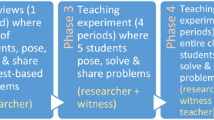Abstract
A small-group, web-interactive approach to teaching precalculus concepts was investigated. Following an online pretest, 3 participants were given a brief (15 min) presentation on the details of reciprocal math relations and how they operate on the coordinate axes. During baseline, participants were tested regarding their ability to construct formulas for a diversified series of graphs. This was followed by online, construction-based, small-group training procedures focusing on the construction of mathematical functions and a test of novel relations. Participants then received group training in accordance with frames of coordination (same as) and frames of opposition (reciprocal of) formula- to-graph relations. Online assessment indicated that participants showed substantial improvement over baseline and pretest performances. This was true even though, during the tests of novel relations, graphs were displayed with scattered data points instead of solid lines on the coordinate axes. Although one participant was unable to complete the second half of the experiment, we were able to train this small group employing approximately the same number of exposures needed for individual training in previous research.
Similar content being viewed by others
References
BALDI, S., JIN, Y., SKEMER, M., GREEN, P. J., & HERGET, D. (2007). Highlights from Pisa 2006: Performance of U.S. 15-year-old students In science and mathematics literacy In an international context (Nces 2008-016). Washington, DC: National Center for Education Statistics, Institute of Education Sciences, U.S. Department of Education.
BINDER, C. (1996). Behavioral fluency: Evaluation of a new paradigm. The Behavior Analyst, 19, 163–197.
ENGLEMANN, S., CARNINE, D., & STEELY, D. G. (2001). Making connections In mathematics. Journal of Learning Disabilities, 24, 292–303.
ENSLEY, D., & KASKOSZ, B. (2008). Flash and math applets: Learn by example. Introduction to Action Script programming for mathematics and science teaching and learning. Charleston, SC: BookSurge Publishing.
FIELDS, L., TRAVIS, R., YADLOVKER, E., ROY, D., DE AGUIAR-ROCHA, L., & STURMEY, P. Equivalence class formation: A method for teaching statistical interactions. Journal of Applied Behavior Analysis, 42, 575—593.
FIENUP, D. M., COVEY, D. P., & CRITCHFIELD, T. S. (2010). Teaching brain-behavior relations economically with stimulus equivalence technology. Journal of Applied Behavior Analysis, 43, 19–33.
FIENUP, D., & CRITCHFIELD, T. (in press). Efficiently establishing concepts of inferential statistics and hypothesis decision making through contextually controlled equivalence classes. Journal of Applied Behavior Analysis.
HAYES, S. C., BARNES-HOLMES, D., & ROCHE, B. (2001). Relational frame theory: A post- Skinnerian account of human language and cognition. New York: Kluwer Academic/Plenum Publishers.
MACE, F.C., & CRITCHFIELD, T. S. (2010). Translational research In behavior analysis: Historical traditions and imperatives for the future. Journal of the Experimental Analysis of Behavior, 93, 293–312.
MARCHAND-MARTELLA, N. E., SLOCUM, T., & MARTELLA, R. C. (2004). Introduction to direct instruction. Boston: Pearson.
NASH, T. (2007). Accelerated C# 2008. Berkeley, CA: Apress.
NATIONAL SCIENCE BOARD. (2006). Science and engineering indicators 2006. Arlington, VA: National Science Foundation.
NINNESS, C., BARNES-HOLMES, D., RUMPH, R., MCCULLER, G., FORD, A., PAYNE, R., NINNESS, S., SMITH, R., WARD, T., & ELLIOTT, M. (2006). Transformation of mathematical and stimulus functions. Journal of Applied Behavior Analysis, 39, 299–321.
NINNESS, C., DIXON, M., BARNES-HOLMES, D., REHFELDT, R. A., RUMPH, R., MCCULLER, G., HOLLAND, J., SMITH, R., NINNESS, S., & MCGINTY, J. (2009). Constructing and deriving reciprocal trigonometric relations: A functional analytic approach. Journal of Applied Behavior Analysis, 42, 191–208.
NINNESS, C., RUMPH, R., MCCULLER, G., HARRISON, C., FORD, A. M., & NINNESS, S. (2005a). A functional analytic approach to computer-interactive mathematics. Journal of Applied Behavior Analysis, 38, 1–22.
NINNESS, C., RUMPH, R., MCCULLER, G., VASQUEZ, E., HARRISON, C., FORD, A. M., NINNESS, S. K., & BRADFIELD, A. (2005b). A relational frame and artificial neural network approach to computer-interactive mathematics. The Psychological Record, 51, 561–570.
PETERS, K. (2007). Foundation Action Script 3.0 animation: Making things move! Berkeley, CA: Apress.
PROGRAM FOR INTERNATIONAL STUDENT ASSESSMENT. (2006). Pisa 2006 Science Competencies for Tomorrow’s World. Retrieved October 4, 2007, from http://www.oecd.org/dataoecd/16/28/39722597.pdf
SCHMIDT, W., HOUANG, R., & COGAN, L. (2002). A coherent curriculum: The case of mathematics. American Educator, 26, 10–26, 47-48.
SIDMAN, M. (1986). Functional analysis of emergent verbal classes. In T. Thompson & M. D. Zeiler (Eds.), Analysis and integration of behavioral units (pp. 213–245). Hillsdale, NJ: Erlbaum.
SKINNER, B. F. (1973). The free and happy student. Phi Delta Kappan, 55(1), 13–16.
STEWART, I., BARNES-HOLMES, D., ROCHE, B., & SMEETS, P. M. (2001). Generating derived relational networks via the abstraction of common physical properties: A possible model of analogical reasoning. The Psychological Record, 51, 381–408.
SULLIVAN, M. (2002). Precalculus (6th ed.). Upper Saddle River, NJ: Prentice Hall.
Author information
Authors and Affiliations
Additional information
Portions of this paper were presented at the 34th Annual Conference of the Association for Behavior Analysis.
Rights and permissions
About this article
Cite this article
McGinty, J., Ninness, C., McCuller, G. et al. Training and Deriving Precalculus Relations: A Small-Group, Web-Interactive Approach. Psychol Rec 62, 225–242 (2012). https://doi.org/10.1007/BF03395799
Published:
Issue Date:
DOI: https://doi.org/10.1007/BF03395799




